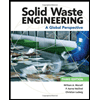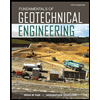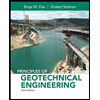c. Calculate the sludge volume (ft³/day) that the digesters must stabilize each day. d. If the h:D = 2 for each digester, calculate the volume (ft³) of each. e. Determine the diameter and height of each digester. Ans: D=15ft, H=29ft
c. Calculate the sludge volume (ft³/day) that the digesters must stabilize each day. d. If the h:D = 2 for each digester, calculate the volume (ft³) of each. e. Determine the diameter and height of each digester. Ans: D=15ft, H=29ft
Solid Waste Engineering
3rd Edition
ISBN:9781305635203
Author:Worrell, William A.
Publisher:Worrell, William A.
Chapter4: Mechanical Processes
Section: Chapter Questions
Problem 4.2P
Related questions
Question
Please answer parts c, d, and e

Transcribed Image Text:Design three solids handling unit processes: (a) an anaerobic digester to treat a plant's
primary sludge, (b) a thickener to increase the solids concentration in a plant's
secondary sludge (activated sludge), and then (c) an aerobic digester to stabilize these
secondary solids. The plant has an average day flow of 120mgd.
1. Anaerobic Digester – Assume a sludge temperature of 60° with 72% volatile matter
in the settled solids and a digester solids retention time (SRT) of 17 days. You have
decided to provide 8 cylindrical, anaerobic digesters.
a. Calculate the mass of sludge wasted (lb/day) that each digester will have to
stabilize if the TSS removed by the primary clarifier is 150 mg/l, producing sludge
with 95% water content.
(Ans: 375,621 lb/day)
b. If the specific gravity of the fixed solids is 2.60 and the specific gravity of the
volatile solids is 1.30, calculate the specific gravity (S) of the TSS in the primary
treatment and then the specific gravity (Ss¹) of the sludge (Eq. 14-1, p.1456(ed4)
or Eq. 13-1, p.1459(ed5))
(Ss = 1.51 & Ssl = 1.02)
c.
Calculate the sludge volume (ft³/day) that the digesters must stabilize each day.
d. If the h:D = 2 for each digester, calculate the volume (ft³) of each.
e. Determine the diameter and height of each digester.
Ans: D=15ft, H=29ft
Expert Solution
This question has been solved!
Explore an expertly crafted, step-by-step solution for a thorough understanding of key concepts.
This is a popular solution!
Trending now
This is a popular solution!
Step by step
Solved in 4 steps

Knowledge Booster
Learn more about
Need a deep-dive on the concept behind this application? Look no further. Learn more about this topic, civil-engineering and related others by exploring similar questions and additional content below.Recommended textbooks for you

Solid Waste Engineering
Civil Engineering
ISBN:
9781305635203
Author:
Worrell, William A.
Publisher:
Cengage Learning,


Traffic and Highway Engineering
Civil Engineering
ISBN:
9781305156241
Author:
Garber, Nicholas J.
Publisher:
Cengage Learning

Solid Waste Engineering
Civil Engineering
ISBN:
9781305635203
Author:
Worrell, William A.
Publisher:
Cengage Learning,


Traffic and Highway Engineering
Civil Engineering
ISBN:
9781305156241
Author:
Garber, Nicholas J.
Publisher:
Cengage Learning

Fundamentals of Geotechnical Engineering (MindTap…
Civil Engineering
ISBN:
9781305635180
Author:
Braja M. Das, Nagaratnam Sivakugan
Publisher:
Cengage Learning

Principles of Geotechnical Engineering (MindTap C…
Civil Engineering
ISBN:
9781305970939
Author:
Braja M. Das, Khaled Sobhan
Publisher:
Cengage Learning

Principles of Foundation Engineering (MindTap Cou…
Civil Engineering
ISBN:
9781337705028
Author:
Braja M. Das, Nagaratnam Sivakugan
Publisher:
Cengage Learning